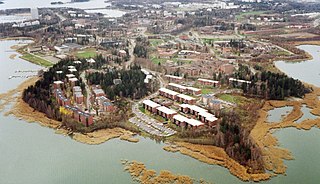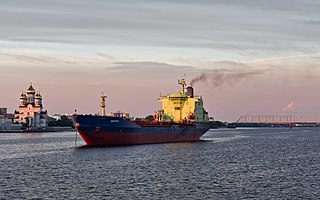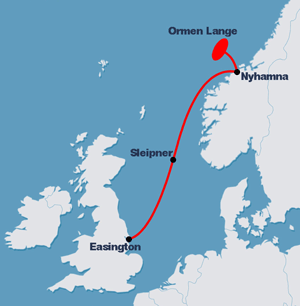
Otaniemi (Finnish), or Otnäs (Swedish), is a district of Espoo, Finland. It is located near the border of Helsinki, the capital of Finland.

Helsinki University of Technology was a technical university in Finland. It was located in Otaniemi, Espoo in the Helsinki metropolitan area. The university was founded in 1849 by Grand Duke of Finland, Emperor Nicholas I and received university status in 1908. It moved from Helsinki to Otaniemi campus area in 1966. The merger of HUT with two other schools created the Aalto University in 2010, and HUT briefly held the name Aalto University School of Science and Technology before being split into four schools in 2011.

An icebreaker is a special-purpose ship or boat designed to move and navigate through ice-covered waters, and provide safe waterways for other boats and ships. Although the term usually refers to ice-breaking ships, it may also refer to smaller vessels, such as the icebreaking boats that were once used on the canals of the United Kingdom.

MSV Fennica is a Finnish multipurpose icebreaker and offshore support vessel. Built in 1993 by Finnyards in Rauma, Finland and operated by Arctia Offshore, she was the first Finnish icebreaker designed to be used as an escort icebreaker in the Baltic Sea during the winter months and in offshore construction projects during the open water season. Fennica has an identical sister ship, Nordica, built in 1994.

Seabed gouging by ice is a process that occurs when floating ice features drift into shallower areas and their keel comes into contact with the seabed. As they keep drifting, they produce long, narrow furrows most often called gouges, or scours. This phenomenon is common in offshore environments where ice is known to exist. Although it also occurs in rivers and lakes, it appears to be better documented from oceans and sea expanses.

A pressure ridge, when consisting of ice in an oceanic or coastal environment, is a linear pile-up of sea ice fragments formed in pack ice by accumulation in the convergence between floes.
In fluid dynamics and elasticity, hydroelasticity or flexible fluid-structure interaction (FSI), is a branch of science which is concerned with the motion of deformable bodies through liquids. The theory of hydroelasticity has been adapted from aeroelasticity, to describe the effect of structural response of the body on the fluid around it.

Aalto University is a public research university located in Espoo, Finland. It was established in 2010 as a merger of three major Finnish universities: the Helsinki University of Technology, the Helsinki School of Economics and the University of Art and Design Helsinki. The close collaboration between the scientific, business and arts communities is intended to foster multi-disciplinary education and research.
Aker Arctic Technology Oy is a Finnish engineering company that operates an ice model test basin in Helsinki. In addition to ship model testing, the company offers various design, engineering and consulting services related to icebreakers, other icegoing vessels and arctic offshore projects as well as full scale trials, field expeditions and training for icy conditions. Formerly the arctic research centre of Wärtsilä and later Masa-Yards, Aker Arctic was established on 30 December 2004 as an independent company with Finnish Industry Investment Ltd, ABB and Aker Solutions as its current shareholders.

MT Indiga was an ice-strengthened product tanker that sailed under the Finnish flag in 1976–2003 and under the Russian flag in 2003–2021. After her modernization in 1994 she became the second merchant ship, after her sister ship Varzuga, to be equipped with an electric azimuth thruster called Azipod.

MT Varzuga was an ice-strengthened product tanker that sailed under the Finnish flag in 1977–2003 and under the Russian flag in 2003–2021. After her modernization in 1993, she became the first merchant ship to be equipped with Azipod, an electric azimuthing propulsion unit developed in Finland in the late 1980s. She was also the first non-Soviet ship to transit the Northern Sea Route.
A double acting ship is a type of icebreaking ship designed to travel forwards in open water and thin ice, but turn around and proceed astern (backwards) in heavy ice conditions. In this way, the ship can operate independently in severe ice conditions without icebreaker assistance but retain better open water performance than traditional icebreaking vessels.

Aalto University School of Electrical Engineering is a part of the Aalto University and works in the area of basic research as well as in the field of latest technologies. School's four departments and the special units widely cover the fields of electronics, communications and automation. Special fields include automation and systems technology, electronics and information technology, power engineering, (wireless) communications engineering and bioinformation technology. The school provides engineering education for both Finnish and international students.

MSV Botnica is a multipurpose offshore support vessel and icebreaker built by Finnyards in Rauma, Finland, in 1998. She was the newest and technically most advanced state-owned icebreaker of Finland until 2012, when she was sold to the Port of Tallinn for 50 million euro. Botnica is used as an escort icebreaker in the Baltic Sea during the winter months, but carries out subsea and offshore construction works worldwide during the open water season.
Arcticaborg (Арктикаборг) is an icebreaking platform supply vessel. She was previously operated by Wagenborg Kazakhstan in the Caspian Sea but was transferred to Canada in 2017 and acquired by Fathom Offshore in 2018. In 2019, she was contract to Russia for two years.
Georgiy Sedov is an icebreaking platform supply vessel operated by Rosmorport in the Sea of Azov. She was built by Kværner Masa-Yards in Helsinki, Finland, in 1998 as Antarcticaborg for Wagenborg Kazakhstan to be used in the Caspian Sea.

MSV Nordica is a Finnish multipurpose icebreaker and offshore support vessel. Built in 1994 by Finnyards in Rauma, Finland, and operated by Arctia Offshore, she and her sister ship Fennica were the first Finnish icebreakers designed to be used as escort icebreakers in the Baltic Sea during the winter months and in offshore construction projects during the open water season.

An oblique icebreaker is a special type of icebreaker designed to operate not only ahead and astern, but also obliquely (sideways) with a large angle of attack. In this way, a relatively small icebreaker is capable of opening a wide channel in ice for large merchant ships.

A submarine pipeline is a pipeline that is laid on the seabed or below it inside a trench. In some cases, the pipeline is mostly on-land but in places it crosses water expanses, such as small seas, straits and rivers. Submarine pipelines are used primarily to carry oil or gas, but transportation of water is also important. A distinction is sometimes made between a flowline and a pipeline. The former is an intrafield pipeline, in the sense that it is used to connect subsea wellheads, manifolds and the platform within a particular development field. The latter, sometimes referred to as an export pipeline, is used to bring the resource to shore. Sizeable pipeline construction projects need to take into account many factors, such as the offshore ecology, geohazards and environmental loading – they are often undertaken by multidisciplinary, international teams.

Baltika is a Russian icebreaker built by Arctech Helsinki Shipyard in Helsinki, Finland. She is the first ship ever built with an asymmetric hull that allows her to operate not only ahead and astern, but also obliquely (sideways) with a large angle of attack. In this way, the relatively small oblique icebreaker is capable of opening a wide channel in ice for large merchant ships.















